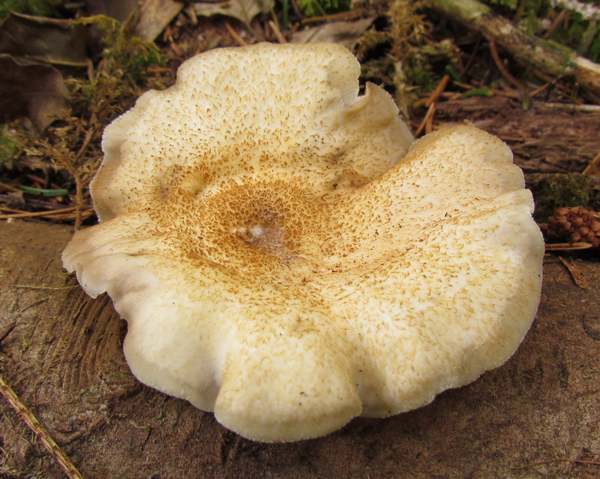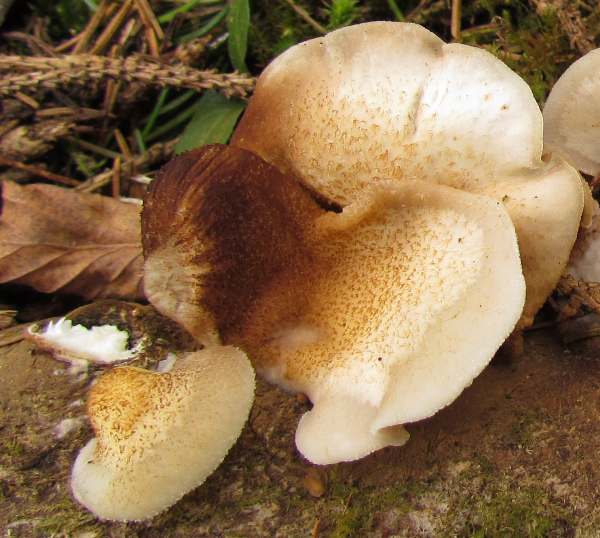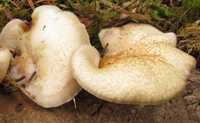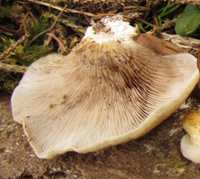Crepidotus calolepis (Fr.) P. Karst. - Scaly Oysterling
Phylum: Basidiomycota - Class: Agaricomycetes - Order: Agaricales - Family: Inocybaceae
Distribution - Taxonomic History - Etymology - Culinary Notes - Identification - Reference Sources

Crepidotus calolepis, is an oysterling very similar to Crepidotus mollis, the Peeling Oysterling. It is usually a fan-shaped but occasionally (as shown in the main picture on this page) rosette-shaped rubbery fungus that grows on the trunks and stumps of dead broad-leaf trees. It is inedible.
Distribution
This oysterling occurs on mainland Europe, but to date there is no conclusive evidence that British records are other than scaly forms of C. mollis.

Taxonomic history
In 1873 the great Swedish mycologist Elias Magnus Fries described this mushroom and gave it the binomial scientific name Agaricus calolepis. (In the early days of fungal taxonomy most gilled species were initially placed in a huge Agaricus genus, since largely redistributed to other newer genera.) It was the Finnish mycologist Petter Adolf Karsten (1834 - 1917) who transferred this species to the genus Crepidotus, establishing its currently accepted scientific name as Crepidotus calolepis.
Synonyms of Crepidotus calolepis include Agaricus calolepis Fr., and Crepidotus mollis var. calolepis (Fr.) Pilát.
Etymology
The generic name Crepidotus comes from crepid- meaning a base such as a shoe or a slipper (although some sources state that it means 'cracked'), and otus, meaning an ear - hence it suggests a 'slipper-like ear'. In the past mushrooms in this genus were sometimes referred to as slipper mushrooms. The specific epithet calolepis may come from the roots calo- meaning beautiful and lepis, meaning with scales. This woodland fungus certainly does produce some very beautiful scaly-capped mushrooms.
Identification guide
 |
CapInitially pale but covered with minute dark-brown scales, the kidney-shaped caps turn ochre-brown with age. Faint striations are sometimes visible towards the margin of the cap, which has a gelatinous layer in the upper part of the flesh; this layer is very elastic, and when it is stretched a see-through window can be created. The cap flesh is white, very watery and easily broken. |
 |
GillsThe pale brown gills fan out from the attachment point; they are soft and gelatinous. As the fruitbody ages, the spores mature and the gills turn rusty brown from the centre. StemUsually there is no visible stipe (stem), the attachment to the substrate being at one edge of the cap from which the gills radiate. Exceptionally the attachment may be at a central point, with a stemless rosette-like fruitbody resulting. |
SporesEllipsoidal, smooth, thick-walled, 7-10 x 5-6.5μm Spore printSnuff brown. |
|
Odour/taste |
Not distinctive. |
Habitat & Ecological role |
Saprobic, on stumps, dead trunks and fallen branches of deciduous trees, mainly poplars; sometimes emerging from cracks in living poplar trees. |
Season |
Late summer and autumn in Britain and Ireland. |
Similar species |
Crepidotus mollis lacks (or has very few) dark brown scales on its cap surface. Crepidotus calolepis is considered by some authorities to be merely a scaly form or variety of Crepidotus mollis. |
Culinary Notes
This rare summer and autumn species is of dubious edibility and may even be poisonous. Care is needed, therefore, when collecting edible Oyster Mushrooms, Pleurotus ostreatus, to avoid accidentally gathering Crepidotus calolepis instead. The brownish spore print of oysterling mushrooms readily distinguish them from edible Oyster Mushrooms, whose spore prints are white.
Reference Sources
Fascinated by Fungi, 2nd Edition, Pat O'Reilly 2016, reprinted by Coch-y-bonddu Books in 2022.
Dictionary of the Fungi; Paul M. Kirk, Paul F. Cannon, David W. Minter and J. A. Stalpers; CABI, 2008
Taxonomic history and synonym information on these pages is drawn from many sources but in particular from the British Mycological Society's GB Checklist of Fungi.
Fascinated by Fungi. Back by popular demand, Pat O'Reilly's best-selling 450-page hardback book is available now. The latest second edition was republished with a sparkling new cover design in September 2022 by Coch-y-Bonddu Books. Full details and copies are available from the publisher's online bookshop...

